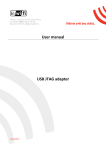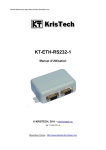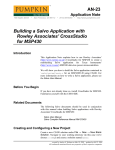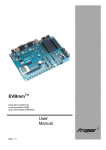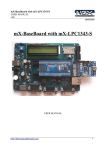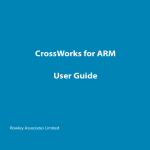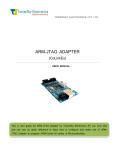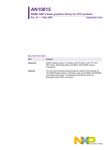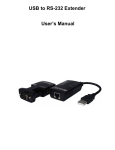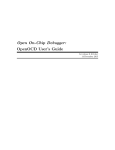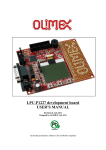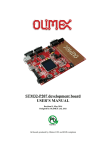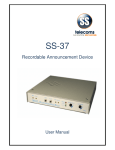Download KT-LINK - Kristech
Transcript
KT-LINK User Manual ver. 02.05.2011-A © KRISTECH 2009-2011 www.kristech.eu 2 1. Introduction KT-LINK is a JTAG interface for ARM-core microcontrollers. It enables program launching and monitoring (memory reading and writing, breakpoint setting, register viewing, single stepping, etc.), as well as Flash memory programming within selected families of ARM-core microcontrollers. The KT-LINK interface connects to a PC via a USB port. Connection to the target system is accomplished via a standard 2x10 pin connector. The interface also contains a virtual serial port, which may be useful in computers that have no RS232 port. Key features of KT-LINK: • USB 2.0 High Speed 480 MHz, • support for adaptive clocking, • wide range of target voltage: 1.65 to 5.5V (5V, 3.3V, 2.5V, 1.8V), • target voltage and supply current can be measured, • hardware support for SWD (Serial Wire Debug) and SWV (Serial Wire Viewer), • standard 2x10 pin ARM connector, • 2 LEDs (USB/RUN, RxD/TxD), • no power supply required, powered through USB, virtual RS232 port with all DB9 connector signals (RXD, TXD, RTS, CTS, DTR, DSR, DCD, RI), • serial port works in RS-232 mode or wide range of voltage (5V, 3.3V, 2.5V, 1.8V) selectable by user, • • target power supply with overload protection (via JTAG connector or EXT connetor). 2. JTAG Interface Connector The figure below shows a JTAG interface connector, which should be installed on a target board (top view). This is a standard 2.54 mm (0.1") pin connector included in ARM Ltd. specifications. Pin number 19 can be used to power the target. In this case, set the jumper pins 1-3 EXT. KT-LINK 3 3. LEDs The KT-LINK interface has two LEDs indicating the interface status. USB/RUN When the LED is on, it indicates that the interface is installed on the PC and there is power applied to the USB port. USB/RUN The LED flashes when the target system is operating. RXD/TXD It indicates that data is received via the RS232 link. RXD/TXD It indicates that data is transmitted via the RS232 link. 4. Drivers and software Drivers are available on CD in the Drivers directory. There are two types of drivers: • • D2XX (drivers provided by FTDI, VID = 0x0403, PID = 0xBBE2), libftdi (LGPL 2.1 license - not supported by our company). KT-Link interface is supported by the following programs: • • • Open On-Chip Debugger, CooCox CoIDE, CrossWorks for ARM. 4.1. OpenOCD Since the distribution of binary OpenOCD compiled with D2XX libraries violates the GPLv2 license. On the CD is binary compiled using library libftdi and libusb-win32. KT-Link interface work faster using the drivers D2XX in Windows. Therefore, it is recommended compilation of OpenOCD. Before compiling in Windows, please read README file in the root of the project OpenOCD. Scripts for compiling OpenOCD using both types of drivers are available on CD in directory cygwin. Description of the configuration environment for ARM CrossWorks shown in Appendix B of this manual. 4.2. CooCox CoIDE CoIDE is a new, free and highly-integrated software development environment for ARM cortex M3 and M0 based microcontrollers, which includes all the tools necessary to develop high-quality software solutions in a timely and cost effective manner. CoIDE configuration is very easy. From menu click Debug → Debug Configuration and then set the adapter to KT-Link. KT-LINK 4 4.3. CrossWorks The latest version of CrossWorks has KT-LINK on the selection list. So the configuration is very easy. In previous versions, please follow the steps below. 1) From the View or Target menu, click Targets (Ctrl+Alt+T). From the targets window's context menu, click New Target Interface → Generic FT2232 Device . 2) Select the Properties option from the target's context menu. 3) Set properties like on the picture. 4) Then you must set the parameter JTAG Clock Divider. KT-LINK 5 5. EXT connector EXT signals are the following figure. Description of the EXT connector signals is summarized below. Pin Symbol Opis 1 +5V +5V target supply with current measurement 2 GND ground 3 VEXT 19-pin JTAG 4 GND ground 5 B-RXD UART Received Data 6 B-CTS UART Clear To Send 7 B-TXD UART Transmitted Data 8 B--RTS UART Request To Send 9 VCC +3,3V 10 A1 analog input 11 VUART voltage reference for the serial port, if it is not connected the DB9 connector is active, if VUART> 1.65 V then active are signals on the serial port connector EXT 12 VDD target voltage 13 USB+5V-ON +5V 14 A0 analog input 6. RS232 RS232 interface has two connectors: • DB9 - all the signals in the standard RS-232, • EXT goldpin - signals TXD, RXD, RTS, CTS voltage level is determined by the signal VUART EXT. If the input VUART is disconnected then the DB9 connector is active. If the input VUART is connected to voltage of 1.65 V to 5V then active are signals TXD, RXD, RTS, CTS on the EXT connector. Voltage of these signals are dependent on the voltage VUART, so you can use it to communicate with chips supplied 5V, 3.3V, 2.5V, 1.8V. If you switch to SWD mode, RXD signal is not available because it is used by SWV. KT-LINK 6 7. Measurement functions KT-Link interface is able to measure: • • • voltage of the target, target supply current (in case of power from the connector EXT), two voltages in the range 0-10V analog inputs on A0, A1 EXT. KT-Link Measurement software is available on CD. 8. Technical Support To obtain technical support, please contact [email protected] . ARM is registered trademark of ARM Limited. Cortex is a trademark of ARM Limited CrossWorks and CrossStudio are trademarks of Rowley Associates Limited. All other brand names or product names are the property of their respective holders. KT-LINK 7 Appendix A. KT-LINK diagram KT-LINK







